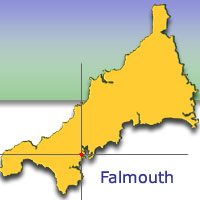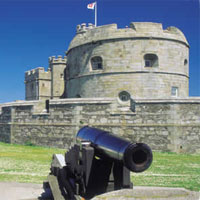
 Coastal Cornwall
Coastal CornwallFalmouth History

 |
||
 |
||
 |
||
 |
||
 |
||
 |
||
 |
||
 |
||
 |
||
 |
||
 |
||
 |
||
 |
||
| Since Tudor times, the Fal Estuary has played a key role in the
defence of the nation. Henry VIII's twin castles of Pendennis and
St. Mawes, both of which can be visited all year, guard the entrance
to one of the finest natural harbours in the world. Pendennis Castle
offers a journey through 450 years of history from a Tudor garrison
to a Second World War base. What's more it is superbly sited on Pendennis
Headland, offering outstanding panoramic views.
Pendennis Castle, 'Cornwall's Greatest Fortress', was built by King Henry VIII and has defended the entrance to the River Fal since its construction between 1540 and 1545. Sitting high on Pendennis Point opposite its sister castle, St Mawes, Pendennis was part of Henry's coastal defences against the threat of an attack from the French and Spanish, following his divorce from Catherine of Aragon. Henry's daughter, Elizabeth I, later added an extra defensive wall around the original fortress.
The Packet Ship service declined yet Falmouth continued to flourish with the introduction of the electric telegraph, making the port one of the few places that ships could call in to get their orders for the delivery of their cargoes. The foundation of Falmouth Docks in 1860 produced a focus for maritime related industries. The railway finally reaching Falmouth by 1863 helped to promote the growing tourist trade, resulting in the first purpose built tourist hotel on the sea front in 1865 and the development of the family bathing beaches of Swanpool, Gyllyngvase and Maenporth. A fascinating leaflet is available from Falmouth Tourist Information
Office that gives details of historic buildings and places of interest
in Falmouth.
|
Coastal Cornwall, Harbour's Reach, King Charles Quay, Falmouth, Cornwall TR11 3HQ
E-mail:info@coastal-cornwall.co.uk Web site design by Slice Internet of Cornwall
A Falmouth Waterfront Holidays web site